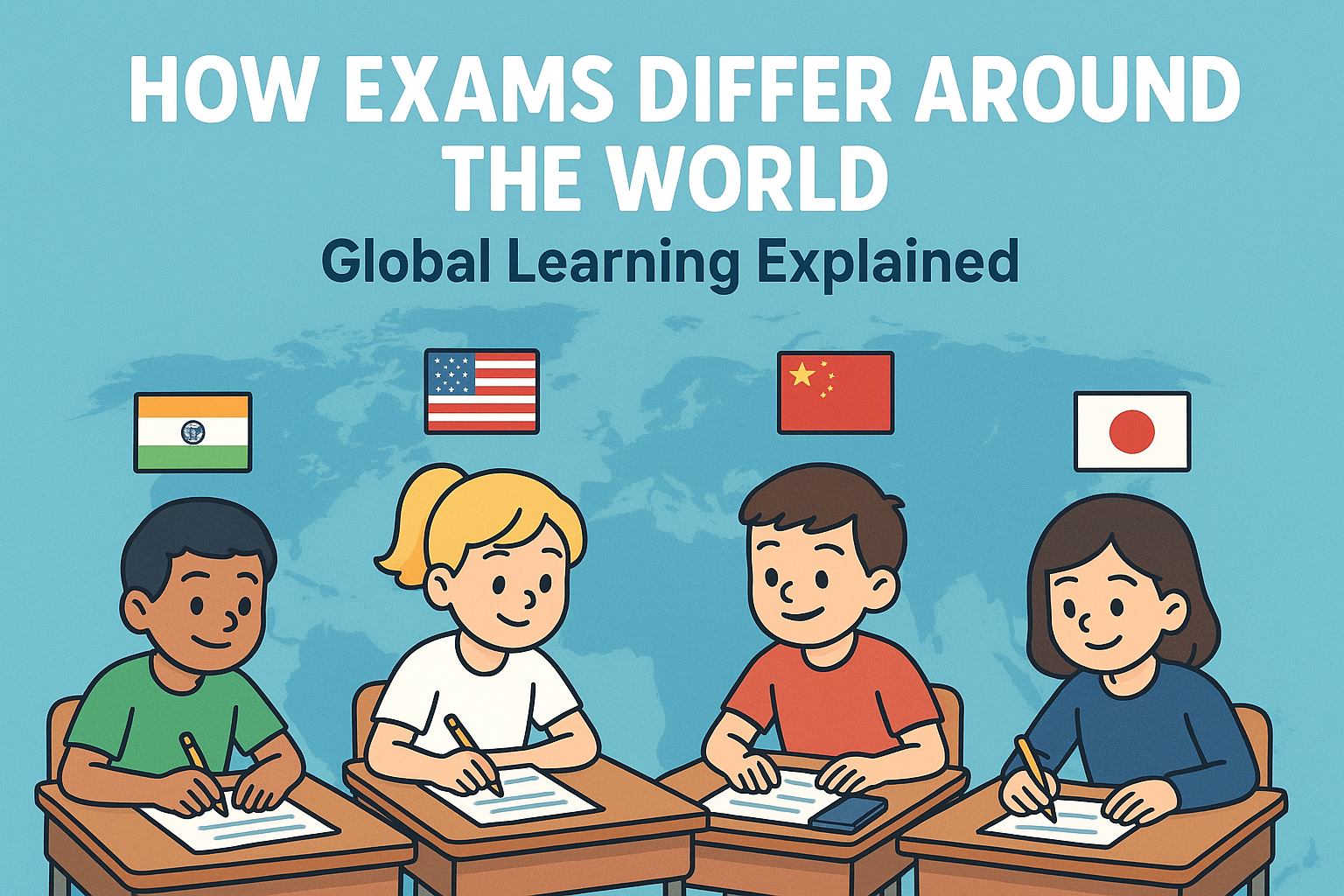The exam conducted in each country varies and this has a significant impact on the students. Each country emphasizes on different aspects which is why the exams differ around the world and the global learning approach also differs.
In this blog you will explore the global education system and how it varies across countries, different college entrance exams, how the student assessment is done and many more.
An Overview of the Global Exam System
| Country | Major Exams | Purpose | Exam Format | Focus Area |
|---|---|---|---|---|
| India | JEE, NEET, CBSE, ICSE, etc | For School and College Entrance Exams | Objectives and Descriptive writing | Memory and Concept |
| USA | SAT, ACT, GRE | For College Admissions | Multiple Choice and Essays | Critical Thinking and Reasoning |
| UK | GCSE, A-Levels | University Admissions | Written and Orals | Analytical and Application Skills |
| Finland | Matriculation Exam | End of Secondary School | Essay and Practical | Problem Solving and Comprehension |
| Japan | National Center Test | University Entrance Exam | MCQ and Essays | Discipline, Accuracy and Recall |
| China | Gaokao | College Entrance Exam | Written | Focus and memory |
| Australia | ATAR | University Entrance Exam | Written and Coursework | Balanced Assessment |
| Germany | Abitur | Higher Education | Oral and Written | Analytical Thinking |
| France | Baccalauréat | University Entrance Exam | Written and Oral | Depth and Interpretation |
| South Korea | Suneung | College Entrance Exam | Objectives and Listening | High-Stakes and Focused Recall |
Exam Preparation in various countries
Every country has their own exam preparation approach. Some follow rigorous exam coaching and late night sessions, whereas some follow independent study and critical discussions.
Following is an overview and comparison between various regions around the world:
| Region | Preparation Style | Study Hours (Average) | Stress Level (Reported) |
|---|---|---|---|
| Asia (India, China, Japan) | Coaching classes, repetition, mock tests | 8–10 hrs/day | Very High |
| Europe (UK, Finland, Germany) | Concept learning, group study, projects | 5–6 hrs/day | Moderate |
| North America (USA, Canada) | Individual prep, online courses, SAT prep | 4–5 hrs/day | Moderate |
| Australia/New Zealand | Coursework + Exams, balanced prep | 3–5 hrs/day | Low to Moderate |
How education policy shapes the exam
Through education policies, the exams are structured, valued and graded. For example:
1. India and China: The exams determine career and education path.
2. Finland and Norway: The exams focus on learning outcomes more which reduces exam stress.
3. USA: The exams focus on continuous assessment and include various assignments, projects, etc.
Different types of Exams around the world
1. Standardized Tests: These tests focus on measurable results and are scalable. For example, SAT, JEE, Gaokao, etc. But these come with high stress and limited creativity.
2. Coursework Based Exam: These exams encourage continuous learning and students are assessed through assignments, essays and presentations.
3. Oral and Practical Exams: These exams focus on communication and real world applications.
4. Holistic Assessment: These exams combine evaluation, class participation and projects. This helps to reduce stress and promotes student development.
Exam Stress and Student performance
No matter which country a student belongs to, some exam stress is always associated with the students and this can affect their performance.
A. Common stress factors include:
1. Fear of failure
2. Pressure from parents
3. Long study hours
4. Competition
B. How Students can cope with it
1. Mediation and mindfulness
2. Group Study
3. Peer support
4. Mock Tests
5. Coaching and mentoring
6. Counselling
Study Abroad and Exam Gap
With globalization, many students are choosing to study abroad. But along with the opportunities, students have to face many challenges as well like adapting to new exam processes. Following is what students can do to adapt to the changes:
1. Understand the local assessment systems
2. Join orientation programs
3. Practice time bound essay writing and critical analysis.
Global Learning and Future Trends
Global education is expanding and so are the opportunities and new trends are also coming. Hybrid assessment is arising and digital platforms and AI-driven student assessments are also reshaping student knowledge measurement.
Some emerging trends in global learning is as follows:
1. Online tests
2. AI graded essays
3. Skill based testing
4. Admissions based on portfolio
Why do Cross Country Comparisons matter?
By studying how exams differ globally you can understand the different aspects that every country focuses more on
For example:
1. Finland: They focus on equity and mental well being of students
2. Japan: They are committed towards discipline
3. USA: They focus on critical thinking
4. India and China: They respect hard work and performance.
FAQ’s
1. Why do exams differ around the world?
Ans: It is because each country has its own education policy and each country has its own approach towards education
2. Which country has the hardest exam?
Ans: China’s Gaokao, India’s UPSC Civil Services Exam and South Korea’s Suneung are considered one of the hardest exam due to high competition and pressure
3. How do college entrance exams vary globally?
Ans: USA uses SAT, ACT, India uses JEE, NEET, etc and UK relies on A-levels. Similarly different countries have their own entrance exams.
4. What role does technology play in global education?
Ans: Through technology, online exams, AI assessments and remote learning can be done.
5. How can International Students adapt to new exam systems?
Ans: By understanding local grading criteria, practicing sample papers, and focusing on skill-based preparation instead of rote learning.
6. How does exam stress differ across various countries?
Ans: It’s highest in exam-centric countries like China, India, and South Korea, and lower in student-centered systems like Finland and Canada.

